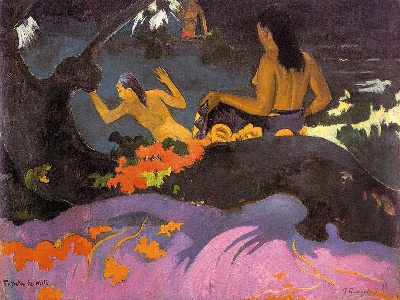(1848 - 1903)
|
Paul Gauguin
(1848 - 1903) |
History has not been kind to Gauguin. It has built up around him the legend of a proud, angry, aggressive man, whose pride eventually became a persecution mania and who spent his life escaping to remote destinations which always disappointed him on arrival and, in the end, robbed him of hope and of life itself. He died in tragic loneliness, on the island of La Dominique in the Marquesas, in 1903.
The escapist who, having escaped, writes to his former friends in accents of self-pity is never a sympathetic character. And in Gauguin's case the mistaken legend of his life has too often given us a prejudice against his art. O fall that group of men whom we rather carelessly label "Post-Impressionist" because they all rebelled against the pseudoscientific objectivity of Impressionism, Gauguin is the one who has been taken least seriously. The passionate intellectualism of Seurat, the painstaking analysis of Cezanne, the turbulent excitement of Van Gogh seem to us more understandable than the escapism of Gauguin. We tend to regard him as a kind of artistic beachcomber. Nothing could be more unjust. The story of his escape from Paris to Brittany in 1886, from Brittany to Tahiti in 1891, his dispirited return in 1895, his second and last escape to Tahiti and the Marquesas Islands - all this is well known. But the word "escape" can imply either a "to" or a "from". and what drew Gauguin away from Europe was a genuine desire to discover an authentically primitive life - the atmosphere that Rousseau had one engendered around his concept of the "noble savage". It may have been an illusory concept, but in Gauguin's case it gave birth to some of the noblest and the most human paintings of the late 19th Century.

Fatat te Mite (which means nothing more significant
than "Beside the Sea") was painted in 1892, a year after his first journey
to Tahiti. It is not difficult to find in it Gauguin's sense of a new-found
freedom. This is not the tourist's discovery of the "noble savage" whose
body has never felt the constraint of clothes. It is as though Gauguin
had used these Tahitians as robust than the Hellenic ideal of physical
beauty which had dominated Europe for so many centuries. Gauguin managed,
as it were, to identify his own life with that of these golden-skinned
children of a tropical island in a tropical sea. The two bathing girls
are his alternative to the water nymphs of Greek vase-painters and sculptors.
They are tougher, more conscious of the need for strength, less of the
desirability of grace.
Gauguin was. throughout his life, a great colourist. By simplifying his forms and eliminating shadow, like the makers of Japanese prints that he so much admired, he could divide up his canvas into a series of bold areas and treat those areas as an excuse for the most daring juxtapositions of colour.
Gauguin's escape to Tahiti was an escape to artistic
freedom in one sense, but in another it was a form of suicide - the suicide
of the civilized man who attempts to force himself into the pattern of
primitivism and succeeds as a artists but fails as a human beings.
| Return to Artists' Eyes | Return to Oxford Eye Page |